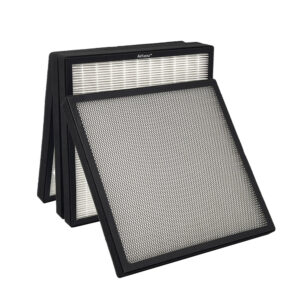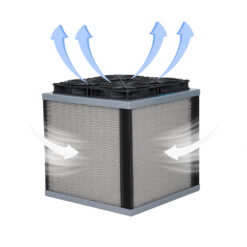When it comes to choosing a room air purifier that meets your needs, there are many specifications and marketing jargon that air purifier manufacturers use, which can be confusing to customers who are unfamiliar with how air purifiers.
Today, we take a look at three commonly used metrics, and see which is the most important metric that should be used to compare air purifiers.
1. Clean Air Delivery Rate (CADR)
CADR is a metric that tells us the volume of air that is cleaned per hour (m³/h).
The CADR value is usually measured by an independent laboratory using smoke, dust, or pollen particles in a closed chamber.
While there isn’t a straightforward formula to calculate CADR, it takes into account several factors:
1. Air flow passing through the filter and the fan(s)
2. Pressure drop (resistance) of the filter
3. Overall filtration efficacy
4. Number of filters used
Given that CADR is determined by those four factors, it is the best metric to use for evaluating an air purifier’s performance.
2. Filter Grade

The filter grade of an air purifier is usually a marketing term to represent the filtration efficacy of the filter.
There are many marketing and technical terms used for filter grades, such as MERV-13, H11, H13, “HEPA-like”, “HEPA-type”, and even “TrueHEPA”.
There isn’t a set of standardized terms that companies use, however nearly all filter grades represent the filtration efficacy of particles at 0.3 microns, the hardest, but not the smallest, particle size to filter.
For example, MERV-13 filters at least 75% of 0.3 micron particles, H11 filters at least 95%, and H13 filters at least 99.5% in a single pass.
However, this does not mean that the filters remove that percentage of particles in a room – it refers to the percentage of particles that are captured in a single pass when air passes through the filter. As long as the air purifier keeps running, over time the percentage of air that is cleaned in the entire room will reach close to 100%.
The question is – how long will it take? Only the CADR can answer that question. The higher the CADR, the faster it will be to clean the air.
As filter grades and filtration efficacy do not take into account variables such as air flow, pressure drop, and number of filters used, they aren’t the best metric to use to evaluate performance. Learn how H11 filters are more effective than H13 filters in our article here.
3. Air Flow
Air flow refers to the volume of air that passes through the air purifier’s fan in an hour (m³/h).
It does not take into account the volume of air that passes through the filter, filtration efficacy, and pressure drop, so you should not use this metric for comparing performance.
Conclusion
The best metric to use is CADR, also known as Clean Air Delivery Rate, as it gives a holistic view of the air purifier’s air flow, pressure drop, filtration efficacy, and number of filters used.
Besides CADR, customers should take note of an air purifier’s noise level and energy consumption at different speed settings. Learn more in our article here.
Or, if you want a powerful air purifier that delivers high performance at a low cost, check out the AirFanta 3Pro.
Room Air Purifier



